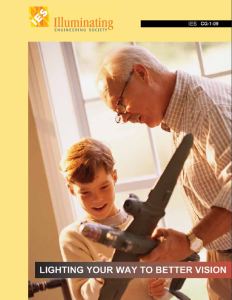Residential Lighting

Image courtesy of IES
A new brochure from the IES considers lighting for Baby Boomers. Read these guidelines on lighting for the aging eyes.
By Susan Bloom
What you need to know:
- Senior citizens are the fastest-growing demographic in the United States
- The aging eye has special lighting needs
- The IES has published literature offering guidelines
- IES recommends higher light levels, no glare, daylight, task lighting where it’s needed
If you’re 65 or older, you’re part of the fastest-growing demographic group in America. According to the U.S. Department of Health and Human Services, in 2009 the nation’s 39.6 million seniors represented about 13% of the U.S. population; by 2030, however, this group is expected to nearly double in size to more than 72 million, or 19% of the population.
Along with the rapid growth of this influential category of Americans comes a host of new products, services, and outreach activities dedicated to the needs and concerns of an older population. One of these is the need for home lighting that is designed especially for the aging eye.
Lighting Your Way to Better Vision, a new brochure from the Illuminating Engineering Society (IES), notes that a number of factors affect our eyesight as we mature, including an increased sensitivity to glare, a need for higher light levels, and age-related ocular conditions, such as macular degeneration and diabetic retinopathy. Good lighting that accommodates and addresses these conditions becomes more important than ever to promote safety, comfort and enjoyment, and to enhance quality of life as we advance through our senior years. Following are some of the IES’s most useful tips on lighting for the aging eye:
Guidelines of good lighting: According to the IES, good lighting for aging eyes includes the use of general, ambient lighting that is consistent from one room to another; higher light levels to compensate for the mature eye’s restricted ability to absorb light; glare-free lighting; and lighting that helps the aging eye to distinguish between colors and compensate for the yellowing of the human lens over time.
Room-to-room enhancements: The IES recommends balancing daylight and ambient light with the addition of some well-placed floor lamps and table lamps in family and living rooms to enhance comfort. (Just make sure that floor lamps have no trailing cords which can cause trip and fall accidents!) In kitchens, linear and strip fluorescent fixtures positioned under cabinets, over the sink and on top of cabinets create an inexpensive, indirect, ambient lighting scheme that is diffused and glare-free. To light a path from the bedroom at night, an illuminated light switch near the bed and nightlights can enhance safe passage, while rope lights installed under outdoor stair rails can provide much-needed additional light in exterior spots. In addition, good task lighting delivered through the use of floor and table lamps will help support the comfortable achievement of activities, such as reading, sewing and other hobbies.
Other tips: To enhance the effectiveness of your lighting and reduce glare, consider painting your walls and ceiling a lighter color and incorporating natural daylight as much as possible through the use of windows and skylights. Also consider upgrading to more modern and energy-efficient light sources, such as halogen, compact fluorescent and LED lighting. These sources not only provide improved coloring, high performance and long life, but they can significantly reduce your energy bills as well.
According to the IES, the presence of “quality environmental lighting can enhance the visual experience and maintain productivity for a lifetime.” For more lighting tips download the IES guidelines for free here.